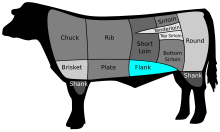kamto
Appearance
Tagalog
[edit]

Alternative forms
[edit]Etymology
[edit]Borrowed from Hokkien, possibly from:
- From 𰯔 (kâm) + 肚 (tǒ͘, “tripe; belly; entrails; animal stomach”), defined as "entrails of sow or ox", according to Chan-Yap (1980). See also 含 (kâm, “to hold shut as the mouth; to hold in the mouth”).
- From 崁 (khàm, “covering”) + 肚 (tǒ͘, “tripe; belly; entrails; animal stomach”), according to Manuel (1948).
Pronunciation
[edit]- (Standard Tagalog) IPA(key): /ˈkamto/ [ˈkam.t̪o], /kamˈto/ [kɐmˈt̪o]
- Rhymes: -amto, -o
- Syllabification: kam‧to
Noun
[edit]kamto or kamtó (Baybayin spelling ᜃᜋ᜔ᜆᜓ)
See also
[edit]References
[edit]- Chan-Yap, Gloria (1980) “Hokkien Chinese borrowings in Tagalog”, in Pacific Linguistics, volume B, number 71 (PDF), Canberra, A.C.T. 2600.: The Australian National University, page 135
- Manuel, E. Arsenio (1948) Chinese elements in the Tagalog language: with some indication of Chinese influence on other Philippine languages and cultures and an excursion into Austronesian linguistics, Manila: Filipiniana Publications, page 29
Categories:
- Tagalog terms borrowed from Hokkien
- Tagalog terms derived from Hokkien
- Tagalog 2-syllable words
- Tagalog terms with IPA pronunciation
- Rhymes:Tagalog/amto
- Rhymes:Tagalog/amto/2 syllables
- Rhymes:Tagalog/o
- Rhymes:Tagalog/o/2 syllables
- Tagalog terms with malumay pronunciation
- Tagalog terms with mabilis pronunciation
- Tagalog lemmas
- Tagalog nouns
- Tagalog terms with Baybayin script
- tl:Cuts of meat
- tl:Meats
